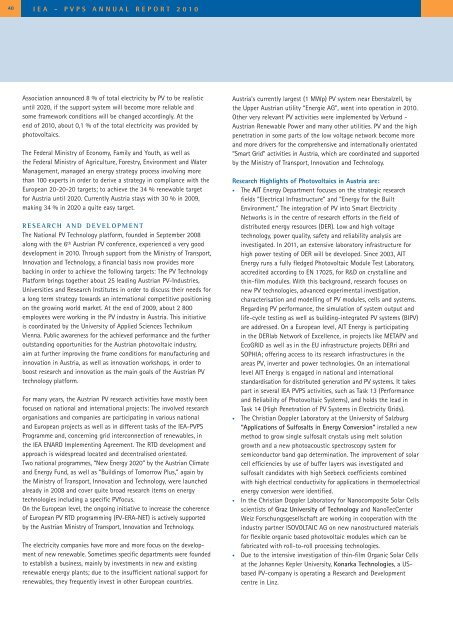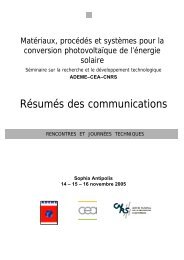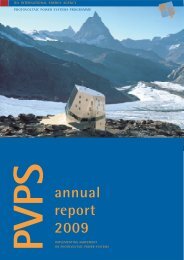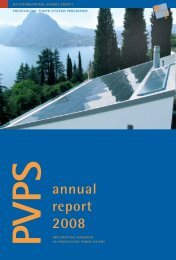Annual Report 2010 - IEA Photovoltaic Power Systems Programme
Annual Report 2010 - IEA Photovoltaic Power Systems Programme
Annual Report 2010 - IEA Photovoltaic Power Systems Programme
You also want an ePaper? Increase the reach of your titles
YUMPU automatically turns print PDFs into web optimized ePapers that Google loves.
40<br />
<strong>IEA</strong> - PVPS ANNUAL REPORT <strong>2010</strong><br />
Association announced 8 % of total electricity by PV to be realistic<br />
until 2020, if the support system will become more reliable and<br />
some framework conditions will be changed accordingly. At the<br />
end of <strong>2010</strong>, about 0,1 % of the total electricity was provided by<br />
photovoltaics.<br />
The Federal Ministry of Economy, Family and Youth, as well as<br />
the Federal Ministry of Agriculture, Forestry, Environment and Water<br />
Management, managed an energy strategy process involving more<br />
than 100 experts in order to derive a strategy in compliance with the<br />
European 20-20-20 targets; to achieve the 34 % renewable target<br />
for Austria until 2020. Currently Austria stays with 30 % in 2009,<br />
making 34 % in 2020 a quite easy target.<br />
RESEARCH AND DEVELOPMENT<br />
The National PV Technology platform, founded in September 2008<br />
along with the 6 th Austrian PV conference, experienced a very good<br />
development in <strong>2010</strong>. Through support from the Ministry of Transport,<br />
Innovation and Technology, a financial basis now provides more<br />
backing in order to achieve the following targets: The PV Technology<br />
Platform brings together about 25 leading Austrian PV-Industries,<br />
Universities and Research Institutes in order to discuss their needs for<br />
a long term strategy towards an international competitive positioning<br />
on the growing world market. At the end of 2009, about 2 800<br />
employees were working in the PV industry in Austria. This initiative<br />
is coordinated by the University of Applied Sciences Technikum<br />
Vienna. Public awareness for the achieved performance and the further<br />
outstanding opportunities for the Austrian photovoltaic industry,<br />
aim at further improving the frame conditions for manufacturing and<br />
innovation in Austria, as well as innovation workshops, in order to<br />
boost research and innovation as the main goals of the Austrian PV<br />
technology platform.<br />
For many years, the Austrian PV research activities have mostly been<br />
focused on national and international projects: The involved research<br />
organisations and companies are participating in various national<br />
and European projects as well as in different tasks of the <strong>IEA</strong>-PVPS<br />
<strong>Programme</strong> and, concerning grid interconnection of renewables, in<br />
the <strong>IEA</strong> ENARD Implementing Agreement. The RTD development and<br />
approach is widespread located and decentralised orientated.<br />
Two national programmes, “New Energy 2020” by the Austrian Climate<br />
and Energy Fund, as well as “Buildings of Tomorrow Plus,” again by<br />
the Ministry of Transport, Innovation and Technology, were launched<br />
already in 2008 and cover quite broad research items on energy<br />
technologies including a specific PVfocus.<br />
On the European level, the ongoing initiative to increase the coherence<br />
of European PV RTD programming (PV-ERA-NET) is actively supported<br />
by the Austrian Ministry of Transport, Innovation and Technology.<br />
The electricity companies have more and more focus on the development<br />
of new renewable. Sometimes specific departments were founded<br />
to establish a business, mainly by investments in new and existing<br />
renewable energy plants; due to the insufficient national support for<br />
renewables, they frequently invest in other European countries.<br />
Austria's currently largest (1 MWp) PV system near Eberstalzell, by<br />
the Upper Austrian utility “Energie AG”, went into operation in <strong>2010</strong>.<br />
Other very relevant PV activities were implemented by Verbund -<br />
Austrian Renewable <strong>Power</strong> and many other utilities. PV and the high<br />
penetration in some parts of the low voltage network become more<br />
and more drivers for the comprehensive and internationally orientated<br />
“Smart Grid” activities in Austria, which are coordinated and supported<br />
by the Ministry of Transport, Innovation and Technology.<br />
Research Highlights of <strong>Photovoltaic</strong>s in Austria are:<br />
• The AIT Energy Department focuses on the strategic research<br />
fields “Electrical Infrastructure” and “Energy for the Built<br />
Environment.” The integration of PV into Smart Electricity<br />
Networks is in the centre of research efforts in the field of<br />
distributed energy resources (DER). Low and high voltage<br />
technology, power quality, safety and reliability analysis are<br />
investigated. In 2011, an extensive laboratory infrastructure for<br />
high power testing of DER will be developed. Since 2003, AIT<br />
Energy runs a fully fledged <strong>Photovoltaic</strong> Module Test Laboratory,<br />
accredited according to EN 17025, for R&D on crystalline and<br />
thin-film modules. With this background, research focuses on<br />
new PV technologies, advanced experimental investigation,<br />
characterisation and modelling of PV modules, cells and systems.<br />
Regarding PV performance, the simulation of system output and<br />
life-cycle testing as well as building-integrated PV systems (BIPV)<br />
are addressed. On a European level, AIT Energy is participating<br />
in the DERlab Network of Excellence, in projects like METAPV and<br />
EcoGRID as well as in the EU infrastructure projects DERri and<br />
SOPHIA; offering access to its research infrastructures in the<br />
areas PV, inverter and power technologies. On an international<br />
level AIT Energy is engaged in national and international<br />
standardisation for distributed generation and PV systems. It takes<br />
part in several <strong>IEA</strong> PVPS activities, such as Task 13 (Performance<br />
and Reliability of <strong>Photovoltaic</strong> <strong>Systems</strong>), and holds the lead in<br />
Task 14 (High Penetration of PV <strong>Systems</strong> in Electricity Grids).<br />
• The Christian Doppler Laboratory at the University of Salzburg<br />
“Applications of Sulfosalts in Energy Conversion” installed a new<br />
method to grow single sulfosalt crystals using melt solution<br />
growth and a new photoacoustic spectroscopy system for<br />
semiconductor band gap determination. The improvement of solar<br />
cell efficiencies by use of buffer layers was investigated and<br />
sulfosalt candidates with high Seebeck coefficients combined<br />
with high electrical conductivity for applications in thermoelectrical<br />
energy conversion were identified.<br />
• In the Christian Doppler Laboratory for Nanocomposite Solar Cells<br />
scientists of Graz University of Technology and NanoTecCenter<br />
Weiz Forschungsgesellschaft are working in cooperation with the<br />
industry partner ISOVOLTAIC AG on new nanostructured materials<br />
for flexible organic based photovoltaic modules which can be<br />
fabricated with roll-to-roll processing technologies.<br />
• Due to the intensive investigation of thin-film Organic Solar Cells<br />
at the Johannes Kepler University, Konarka Technologies, a USbased<br />
PV-company is operating a Research and Development<br />
centre in Linz.






